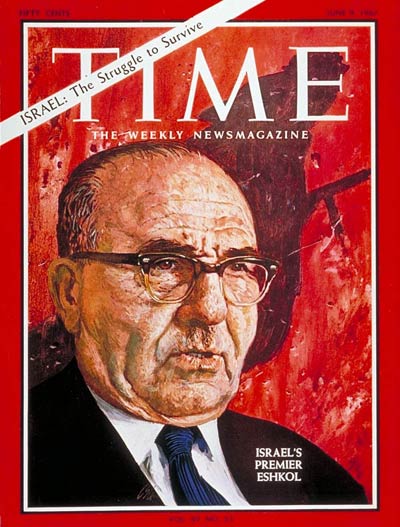
Milestone moments do not a year make. Often, it’s the smaller news stories that add up, gradually, to big history. With that in mind, in 2017 TIME History will revisit the entire year of 1967, week by week, as it was reported in the pages of TIME. Catch up on last week’s installment here.
It was nothing new for the Jewish people in Israel to be under threat, but as TIME’s cover story this week explained, the scale of what was happening in mid-1967 was something new: “Tiny, dagger-shaped Israel, whose 2,700,000 people cling to 7,993 sq. mi. on the shores of the eastern Mediterranean, faced the implacable hostility and cocked guns of 14 Arab nations and their 110 million people.”
As had been reported the previous week, Egypt had barred Israel from accessing the crucial Gulf of Aqaba. In addition, Egypt and Jordan — often at odds with each other — had just signed a defense pact, and Egypt seemed close to something similar with Saudi Arabia. This situation raised fears that Israel, which was more than capable of defending itself against any one of its neighbors, would be left with few options if confronted with a united force. Patrol forces had already begun to clash along the border, creating the sort of environment that could be the spark that started a larger conflagration. Meanwhile, Israel’s economy was faltering and immigration to the still-young nation was declining.
Watching this situation from afar, some people thought that the chance of crisis might be an opportunity to address some of the demands Israel’s neighbors had been making for years, such as allowing displaced Palestinians to return or providing them with payment for their resettling. On the other hand, within Israel the possibility of war seemed to have a galvanizing effect:
Half the nation seemed to be in uniform. The winding highway from the rugged wooded hills of Jerusalem to Tel Aviv on the coast was crowded with reservists hitchhiking to join their units. In the cities, girls in khaki miniskirts and pertly cocked overseas caps were on round-the-clock duty at sandbagged gun positions. Middle-aged men volunteered for temporary police duty, and middle-aged housewives enlisted for service as air-raid wardens. Schoolchildren delivered the mail, and university students paid their own way to remote kibbutzim (collective farms) to replace teachers called to arms. In Jerusalem, two wealthy merchant brothers responded to the emergency by paying up five years of back taxes. In Tel Aviv, an army officer and his wife named their newborn son Tiran after the disputed Strait at the mouth of the Gulf of Aqaba, now under Egyptian blockade.
Even as Premier Levi Eshkol argued for diplomacy — “It is not difficult for the situation to deteriorate into war, but we have to be strong enough to try all other means. We have to do the utmost to avoid bloodshed on either side of the border,” he said — he appointed a new Defense Minister, Gen. Moshe Dayan, and the world waited to see what would happen next.
The U.S. take: The looming crisis in the Middle East was stirring up concern in the U.S., where officials raced to do what they could to prevent a full-on war — especially one that might draw in the Soviets in support of the Arab side. TIME reported that sources in Washington were still hopeful that diplomacy might work, but that it was clear that the United Nations would not be part of reaching a solution.
Who fights: The national news section covered the latest steps in the ongoing conversation about how best to draft American troops to fight in Vietnam, as President Johnson promised reforms that would increase fairness — one of which would be the new draft lottery system that would go into action about two years later.
The birds and the bees: This week’s fascinating TIME Essay tackles the issue of sex education in America’s schools, acknowledging that — while parents and educators had long fretted over what children were being exposed to and when — the 1960s were presenting a new challenge in that arena. It was no surprise, then, that the teaching of the subject was expanding at breakneck speed, lending new urgency to the question of what exactly students would learn in such classes. “We have done away with chaperones, supervision, rules, close family relations, and privacy from the intrusion of the communications media,” one expert explained. “We have left our children totally vulnerable to the onslaughts of the commercial exploitation of sex, tabloid reporting of sordid sexual occurrences, wholly unsupervised after-school occupations. To fill the void left by the old safeguards, youngsters must be given a bulwark of factual knowledge and orientation.”
Glamping: Think “glamping” is a 21st century trend? Think again, and read this story about how 1967’s “campers are increasingly taking all the comforts of home into the wilderness.”
Great vintage ad: This advertisement for an investment adviser plays on the idea that the employee of 1967 was forced to juggle “job, family, and community responsibilities” in a way that left no time for anything else — which sounds an awful lot like a modern conversation about work-life balance.
Coming up next week: More on the war
More Must-Reads from TIME
- Cybersecurity Experts Are Sounding the Alarm on DOGE
- Meet the 2025 Women of the Year
- The Harsh Truth About Disability Inclusion
- Why Do More Young Adults Have Cancer?
- Colman Domingo Leads With Radical Love
- How to Get Better at Doing Things Alone
- Michelle Zauner Stares Down the Darkness
Write to Lily Rothman at lily.rothman@time.com